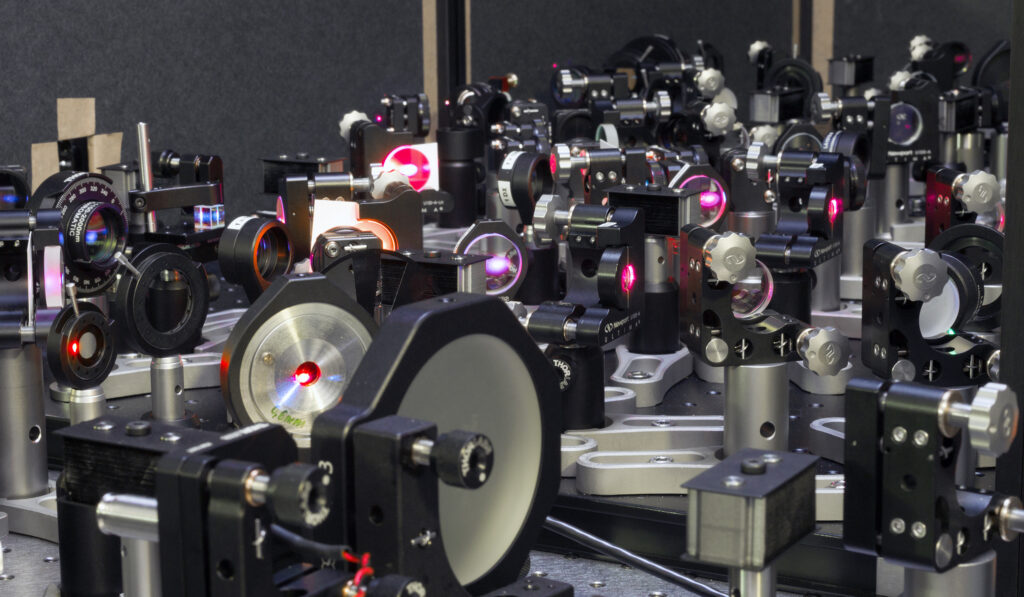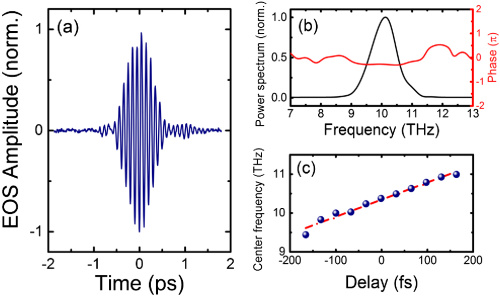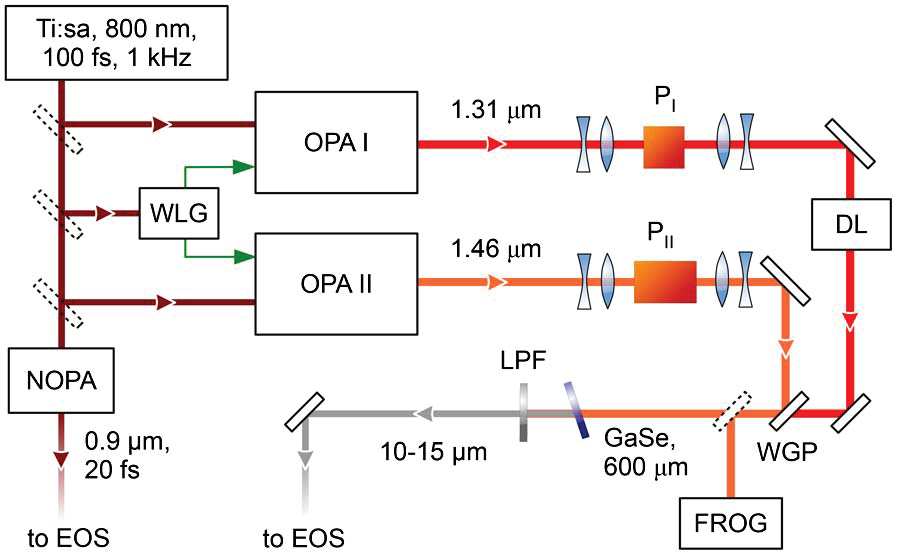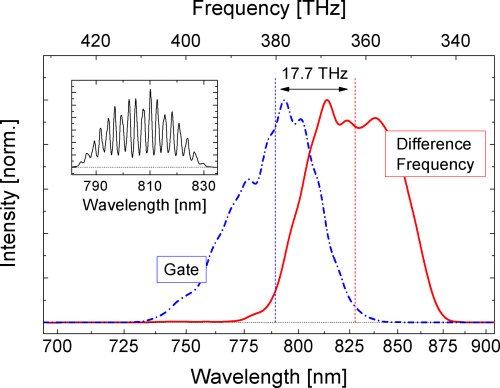Our goal of controlling complex materials via strong excitation at mid-infrared and terahertz frequencies requires the generation of intense light pulses in this frequency band. We obtain frequency tunable mid-infrared pulses between 5 and 60 THz by difference frequency mixing (DFG) of two femtosecond near-infrared pulses, produced by optical parametric amplifiers (OPAs). Some experiments require carrier-envelope phase stability of these excitation pulses, which is achieved by mixing the two signal outputs of two OPAs seeded by the same white light continuum. Using chirped-pulse DFG, we are able to prepare narrowband pulses with bandwidth-limited picosecond durations. Recently, we developed a hybrid CO2-Ti:sapphire laser that produces high-power pulses of up to nanosecond duration at a fixed 10.6 µm wavelength.
Technical publications
Hybrid CO2-Ti:sapphire laser with tunable pulse duration for mid-infrared-pump terahertz-probe spectroscopy
M. Budden, T. Gebert, A. Cavalleri
Optics Express 29, 3 (2021)
Abstract
We describe a mid-infrared pump – terahertz-probe setup based on a CO2 laser seeded with 10.6 μm wavelength pulses from an optical parametric amplifier, itself pumped by a Ti:Al2O3 laser. The output of the seeded CO2 laser produces high power pulses of nanosecond duration, which are synchronized to the femtosecond laser. These pulses can be tuned in pulse duration by slicing their front and back edges with semiconductor-plasma mirrors irradiated by replicas of the femtosecond seed laser pulses. Variable pulse lengths from 5 ps to 1.3 ns are achieved, and used in mid-infrared pump, terahertz-probe experiments with probe pulses generated and electro-optically sampled by the femtosecond laser.
Generation of narrowband, high-intensity, carrier-envelope phase stable pulses tunable between 4 and 18 THz
B. Liu, H. Bromberger, A. Cartella, T. Gebert, M. Först, A. Cavalleri
Optics Letters, 42, 129-131 (2017)
Abstract
We report on the generation of high-energy (1.9 μJ) far-infrared pulses tunable between 4 and 18 THz frequency. Emphasis is placed on tunability and on minimizing the bandwidth of these pulses to less than 1 THz, as achieved by difference-frequency mixing of two linearly chirped near-infrared pulses in the organic nonlinear crystal DSTMS. As the two near-infrared pulses are derived from amplification of the same white light continuum, their carrier envelope phase fluctuations are mutually correlated, and hence the difference-frequency THz field exhibits absolute phase stability. This source opens up new possibilities for the control of condensed matter and chemical systems by selective excitation of low-energy modes in a frequency range that has, to date, been difficult to access.
Narrowband carrier-envelope phase stable mid-infrared pulses at wavelengths beyond 10 μm by chirped-pulse difference frequency generation
A. Cartella, T. F. Nova, A. Oriana, G. Cerullo, M. Först, C. Manzoni, and A. Cavalleri
Optics Letters, 42, 663-666 (2017)
Abstract
We report on the generation of narrowband carrier-envelope phase stable mid-infrared (MIR) pulses between 10 and 15 μm. High pulse energies and narrow bandwidths are required for the selective nonlinear excitation of collective modes of matter that is not possible with current sources. We demonstrate bandwidths of <2% at 12.5 μm wavelength through difference frequency generation between two nearinfrared (NIR) pulses, which are linearly chirped.We obtain a reduction in bandwidth by one order of magnitude, compared to schemes that make use of transform-limited NIR pulses. The wavelength of the narrowband MIR pulse can be tuned by changing the optical delay between the two chirped NIR pulses.
Pulse shaping in the mid-infrared by a deformable mirror
A. Cartella, S. Bonora, M. Först, G. Cerullo, A. Cavalleri, and C. Manzoni
Optics Letters, 39, 1485-1488 (2014)
Abstract
We present a pulse-shaping scheme operating in the mid-infrared (MIR) wavelength range up to 20 μm. The spectral phase is controlled by a specially designed large stroke 32-actuator deformable mirror in a grating-based 4f configuration. We demonstrate the shaper capability of compressing the MIR pulses, imparting parabolic and third-order spectral phases and splitting the spectral content to create two independent pulses.
Single-Shot detection and direct control of carrier phase drift of mid-IR pulses
C. Manzoni, M. Foerst, H. Ehrke, and A. Cavalleri
Optics Letters, 35, 757-759 (2010)
Abstract
We introduce a scheme for single-shot detection and correction of the carrier-envelope phase (CEP) drift of femtosecond pulses at mid-IR wavelengths. Difference frequency mixing between the mid-IR field and a near-IR gate pulse generates a near-IR frequency-shifted pulse, which is then spectrally interfered with a replica of the gate pulse. The spectral interference pattern contains shot-to-shot information of the CEP of the mid-IR field, and it can be used for simultaneous correction of its slow drifts. We apply this technique to detect and compensate long-term phase drifts at 17 𝜇m wavelength, reducing fluctuations to only 110 mrad over hours of operation.






